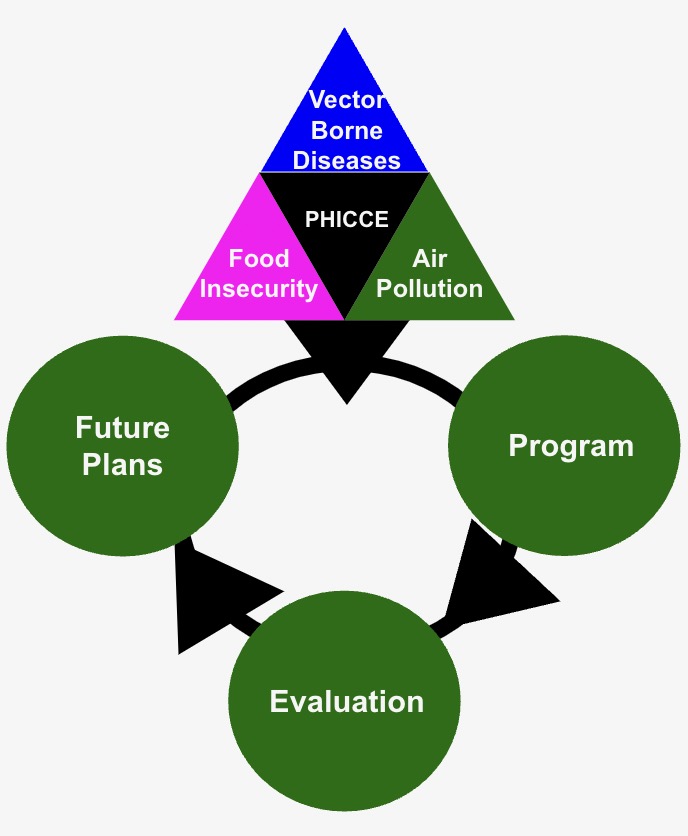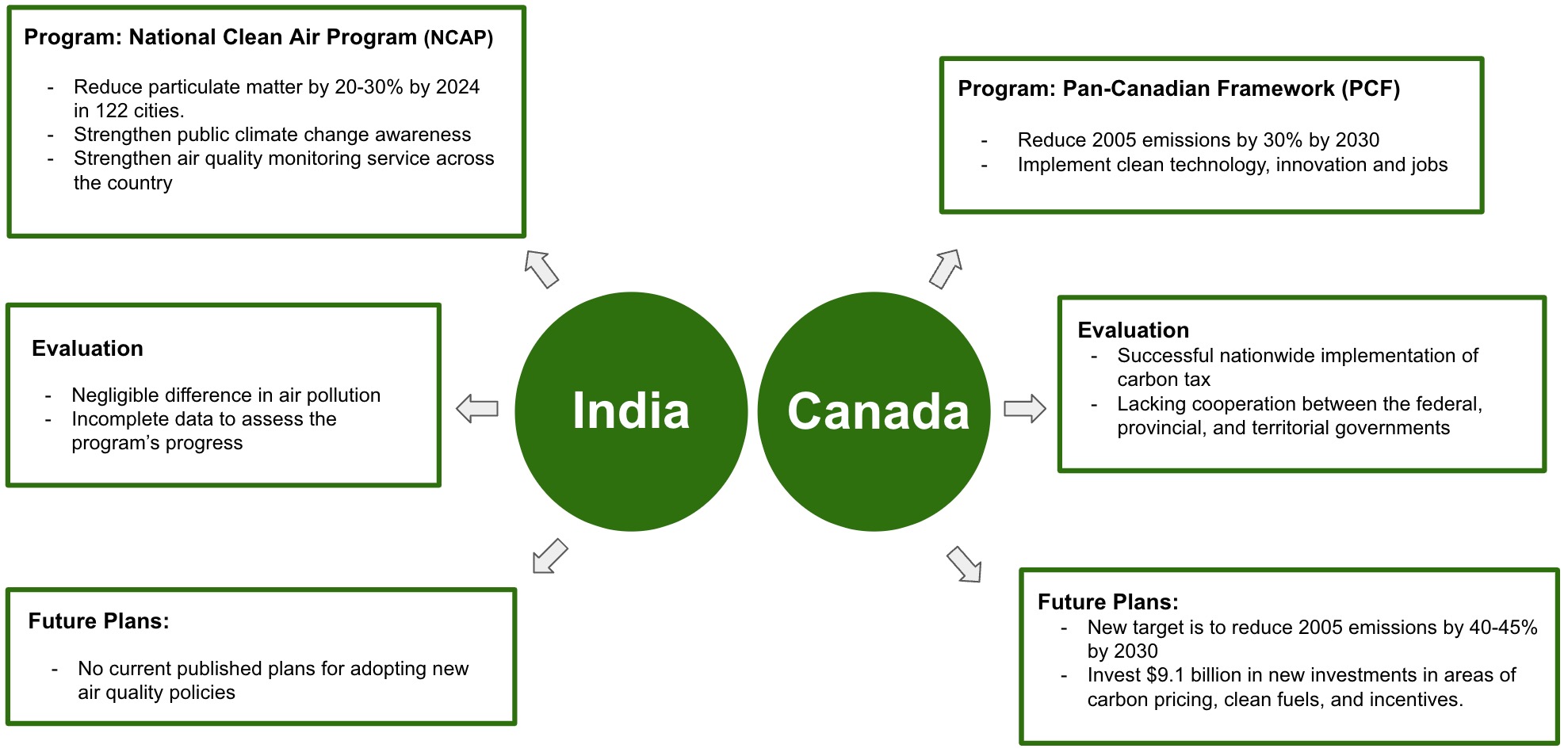A Novel Method to Evaluate Climate Policy
Public Summary
Background Information
In 2015, the United Nations set out 17 Sustainable Development Goals (SDGs) to provide a blueprint for a more prosperous future for both people and the planet (United Nations, 2022). Of such goals, SDG 13 emphasizes the need to take immediate action to combat climate change, adapt our systems to become more resilient and mitigate the harmful impacts it has on populations (United Nations, 2022). With the World Health Organization predicting that 250,000 fatalities will occur every year due to climate change by 2030, we must prioritize public health when implementing policies concerning climate change (World Health Organization, 2022). To do this, a framework has been developed through which national policies relating to public health aspects of SDG 13 can be evaluated. We have conducted an exemplary case study using our framework to evaluate India and Canada’s progress toward SDG 13.
Our Framework
Each nation is unique in demographics and socioeconomic status, thus creating unequal public health burdens and differing national priorities. A conceptual framework that directly analyzes policies has been developed to evaluate and compare nations’ responses to climate threats. Our Public Health in Climate Change Evaluation (PHICCE) framework was created using premises from various groups, including the Canadian Public Health Association and the World Health Organization (Figure 1) (Canadian Public Health Association, 2017; World Health Organization, 2022). The PHICCE framework highlights that program, evaluation, and future plans are three dimensions that can be used to assess a country’s progress toward SDG 13 from a public health lens (Figure 1).

Figure 1: The Public Health in Climate Change Evaluation (PHICCE) framework. Three main climate change factors impact public health: vector-borne disease, air pollution, and food insecurity. Each of these factors can be assessed in the context of achieving SDG 13 through the framework by understanding: (1) the programs that have been implemented; (2) evaluation of the effectiveness of such programs; (3) and understanding their future plans. This content in the PHICCE framework is adopted and based on previous conceptual frameworks (Glasgow, Vogt and Boles, 1999; Canadian Public Health Association, 2017; United Nations, 2022; World Health Organization, 2022; World Health Organization, Regional Office For Europe, 2022).
Implementing our Framework – India and Canada’s Air Pollution Policy
To implement our PHICCE framework, we evaluate Canada and India’s progress toward achieving SDG 13, focusing on air pollution (Figure 2). Both countries have implemented programs to target air pollution in the context of public health: India introduced the National Clean Air Program (NCAP) in 2019, and Canada introduced the Pan-Canadian Framework (PCF) in 2016. However, despite its elaborate plan, India has failed to implement the NCAP successfully–cities report almost no changes in their particulate matter levels (Centre for Research on Energy and Clean Air, 2022). Canada has seen some positive results with regard to lowering emissions; however, many international targets are continually not being met (Ganguly, Selvaraj and Guttikunda, 2020). In terms of future plans, to reach the targets set out by SDG 13, Canada primarily invests in research initiatives to combat air pollution, while India has not published renewed strategies or steps since the initial launch of the NCAP (Government of Canada, 2006; Centre for Research on Energy and Clean Air, 2022). Overall, Canada emphasizes preventative measures, while India has a reactionary approach due to poor air quality events. Overall, it is evident that India is not making adequate progress compared to Canada in its efforts to mitigate the public health burden caused by air pollution.

Figure 2: Applying the Public Health in Climate Change Evaluation (PHICCE) framework to India and Canada in the context of air pollution policy. For each country, one major policy has been highlighted: India’s National Clean Air Program (NCAP) and Canada’s Pan-Canadian Framework (PCF). Through analyzing their program, evaluation, and future plans, findings suggest that Canada is likely more on track than India to achieve its goal of reducing air pollution and thus attaining SDG 13 (Canada Environment and Climate Change, 2016; Centre for Research on Energy and Clean Air, 2022).
Reference List
Canada Environment and Climate Change, 2016. Pan-Canadian Framework on Clean Growth and Climate Change. [online] Available at: https://www.canada.ca/content/dam/themes/environment/documents/weather1/20161209-1-en.pdf [Accessed 16 November 2022].
Canadian Public Health Association, 2017. Public Health: A Conceptual Framework. [online] Available at: https://www.cpha.ca/sites/default/files/uploads/policy/ph-framework/phcf_e.pdf [Accessed 16 November 2022].
Centre for Research on Energy and Clean Air, 2022. Progress Report on National Clean Air Programme (NCAP). [online] Available at: https://energyandcleanair.org/wp/wp-content/uploads/2022/01/NCAP-Report_Jan22_.pdf.
Ganguly, T., Selvaraj, K.L. and Guttikunda, S.K., 2020. National Clean Air Programme (NCAP) for Indian cities: Review and outlook of clean air action plans. Atmospheric Environment: X, 8, p.100096. https://doi.org/10.1016/j.aeaoa.2020.100096.
Glasgow, R.E., Vogt, T.M. and Boles, S.M., 1999. Evaluating the public health impact of health promotion interventions: the RE-AIM framework. American Journal of Public Health, 89(9), pp.1322–1327. https://doi.org/10.2105/AJPH.89.9.1322.
Government of Canada, 2006. Canada’s Clean Air Act. [online] Available at: https://publications.gc.ca/site/eng/300529/publication.html.
United Nations, 2022. — SDG Indicators. [online] Available at: https://unstats.un.org/sdgs/report/2022/ [Accessed 16 November 2022].
World Health Organization, 2022. Climate change. [online] Available at: https://www.who.int/health-topics/climate-change [Accessed 15 November 2022].
World Health Organization, Regional Office For Europe, n.d. Policy Brief: Health and Climate Action. [online] Available at: https://www.euro.who.int/__data/assets/pdf_file/0009/397791/SDG-13-policy-brief.pdf [Accessed 16 November 2022].